Fast Facts
Country Name:
Conventional long form: Republic of the Philippines
Conventional short form: Philippines
Government type: Republic
Capital: Manila
Location: Southeast Asia, achipelago between the Philippine Sea, and the South China Sea and east of Vietnam. The Philippine archipelago is comprises of 7,107 islands; located in relation to many of Southeast Asia’s main water bodies: the Philippine Sea, South China Sea, Celebes Sea, Sulu Sea and Luzon Strait.
Currency: Philippine Peso (Code: PHP) (Symbol: ₱)
International Country Code: 63
National Holidays:
- 25 February (1986): EDSA People Power Revolution
- 9 April (1961): “Araw ng Kagitingan” Day of Valor/ Bataan Day (Observed according to Republic Act No. 3022, 6 April 1961)
- 1 May (1913): “Araw ng mga Manggaggawa” Labor Day (First official celebration of Labor Day)
- 12 June (1898): “Araw ng Kalayaan / Araw ng Kasarinlan” Independence Day (Declaration of Independence from Spain; was celebrated in July 4 from 1947 to 1964 same with United States of America)
- 6 July (2002): “Eid’l Fitr” End of Ramadan (Proclaimed as National Holiday under President Gloria Macapagal-Arroyo)
- 21 August (1983): Ninoy Aquino Day (Commemoration of Assassination of Senator Benigno “Ninoy” Aquino, Jr.; Republic Act 9256 signed by President Gloria Macapagal-Arroyo)
- 30 November (1863): Bonifacio Day (Passed as National Holiday under Act No. 2946 by Philippine Legislature in 1921)
Climate: Tropical marine; northeast monsoon (November to April); southwest monsoon (May to October)
Geographic coordinates: 12.8797° N, 121.7740°E
Area total: 300,000 sq km land: 298,170 sq km water: 1,830 sq km
Coastline: 36,289 km
Terrain: Islands, 65% mountainous with narrow coastal lowlands
Maritime claims: continental shelf: to depth of exploitation territorial sea: irregular polygon extending up to 100 nm from coastline and defined by 1898 treaty; since late 1970s has also claimed polygonal-shaped area in South China Sea up tp 285 nm in breadth; exclusive economic zone: 200 nm
Elevation extremes:
Lowest point: Philippine Sea 0 m
Highest point: Mount Apo 2,954 m
Natural resources: Timber, petroleum, nickel, cobalt, silver, gold, salt, copper
Land use:
Arable land: 18%
Permanent crops: 17.33 %
Other: 64.67% (2011)
Irrigated land: 15,500 sq km (2003)
Environment – Current Issues: Uncontrolled deforestation especially in watershed areas; soil erosion, air and water pollution in major urban centres; coral reef degradation; increasing pollution of coastal mangroves swamps that are important fish breeding grounds
Environment – International Agreements: party to: Biodiversity, Climate Change, Climate Change-Kyoto Protocol, Desertification, Endangered Species, Hazardous Wastes, Law of the Sea, Marine Dumping, Ozone Layer Protection, Ship Pollution, Tropical Timber 83, Tropical Timber 94, Wetlands, Whaling signed, but not ratified: Air Pollution-Persistent Organic Pollutants
Population: 107,668,231 (2014 est.)
Age Structure:
0-14 years: 33.7% (male: 18,493,668; female: 17,753,359)
15-64 years: 61.3% (male: 33,330,715; female: 33,213,754)
65 years and over: 4% (male: 2,103,596; female: 2,773,139) (2014 est.)
Median age:
Total : 23.5 years
Male : 23 years
Female:24 years (2014 est.)
Population growth rate: 1.81% (2014 est.)
Sex ratio:
At birth: 1.05 male(s)/female
Under 15 years: 1.04 male(s)/female
15-64 years: 1.02 male(s)/female
65 years and over: 0.76 male(s)/female
Total population: 1 male(s)/female (2014 est.)
Infant mortality rate:
Total: 17.64 deaths/1,000 live births
Male: 19.99 deaths/1,000 live births
Female: 15.17 deaths/1,000 live births (2014 est.)
Life expectancy at birth:
Total population: 72.48 years
Male: 69.52 years
Female: 75.59 years (2014 est.)
Nationality: noun: Filipino(s) adjective: Philippine
Ethnic groups: Tagalog 24.4%; Ilocano 9.8%; Bisaya 33.8%; Moro 5.1%; Bikolano 6.8%; Others 20.9% (2010 est.)
Languages: official languages: Filipino (based on Tagalog) and English major dialects: Tagalog, Cebuano, Ilocano, Hiligaynon or Ilonggo, Bicol, Waray, Kapampangan and Pangasinense
Literacy: definition: age 15 and over can read and write
Total population: 95.4%
Male: 95%
Female: 95.8% (2008 est.)
Constitution: 2 February 1987, effective 11 February 1987
Suffrage: 18 years of age, universal
Administrative divisions: The Philippines is divided into three island groups: Luzon, Visayas and Mindanao. Divided into 18 regions (17 Administrative & 1 Autonomous), 81 provinces, 145 cities, 1490 municipalities and 42,028 barangays.
Executive branch: President Rodrigo “Rody” Roa Duterte (since 30 June 2016, Both Chief of State and Head of Government); Vice President Leni Robredo (born Maria Leonor Santo Tomas Gerona; since 30 June 2016); Cabinet (to be announced and appointed by the President with consent if Commission on Appointments); Executive Departments; Local Government
Legislative branch: Congress of the Philippines consists of the Senate: Senate President Franklin Drilon, President Pro Tempore Raplh Recto, Majority Floor Leader Alan Peter Cayetano, Minority Floor Leader Juan Ponce Enrile; House of Representatives
Judicial branch: Supreme Court (15 justices are appointed by the president on the recommendation of the Judicial and Bar Council and serve until 70 years of age).; Court of Appeals; Regional Trial Courts; “Sandiganbayan” Special Appellate; Ombudsman; “Katarungan Pambarangay” Barangay Justice
International Organization Participation: ADB, APEC, APT, ARF, ASEAN, BIS, CD, CICA (observer), CP, EAS, FAO, G-24, G-77, IAEA, IBRD, ICAO, ICC (national committees), ICRM, IDA, IFAD, IFC, IFRCS, IHO, ILO, IMF, IMO, IMSO, Interpol, IOC, IOM, IPU, ISO, ITSO, ITU, ITUC (NGOs), MIGA, MINUSTAH, NAM, OAS (observer), OPCW, PCA, PIF (partner), UN, UNCTAD, UNDOF, UNESCO, UNHCR, UNIDO, Union Latina, UNISFA, UNMIL, UNMISS, UNMIT, UNMOGIP, UNOCI, UNWTO, UPU, WCO, WFTU (NGOs), WHO, WIPO, WMO, WTO
Flag: Two equal horizontal bands of blue (top; representing peace and justice) and red (representing courage); a white equilateral triangle based on the hoist side represents equality; the center of the triangle displays a yellow sun with eight primary rays, each representing one of the first eight provinces that sought independence from Spain; each corner of the triangle contains a small, yellow, five-pointed star representing the three major geographical divisions of the country: Luzon, Visayas, and Mindanao.
GDP (purchasing power parity): $454.3 billion (2013 est. in US Dollar)
GDP (official exchange rate): $272.2 billion (2013 est.)
GDP – real growth rate: 6.8% (2013 est.)
GDP – per capita (PPP): $4,700 (2013 est.)
Labor force: 41.33 million (2013 est.)
Labor force by occupation: Agriculture: 32%; Industry: 15%; Services: 53% (2012 est)
Unemployment rate: 7.4% (2013 est.)
Population below poverty line: 26.5% (2009 est.)
Public debt: 50.2% of GDP (2013 est.)
External debt: $72.81 billion (31 December 2013 est.)
Exchange rates: Philippine pesos per US dollar – 42.69 (2013 est.), 42.229 (2012 est.), 45.11 (2010 est.), 47.68 (2009 est.), 44.439 (2008 est.)
Exports: $47.45 billion f.o.b. (2013 est.)
Export partners: Japan 19%, US 14.2%, China 11.8%, Singapore 9.3%, Hong Kong 9.2%, South Korea 5.5%, Thailand 4.7% (2012)
Imports: $63.91 billion f.o.b. (2013 est.)
Imports partners: US 11.5%, China 10.8%, Japan 10.4%, South Korea 7.3%, Singapore 7.1%, Thailand 5.6%, Saudi Arabia 5.6%, Indonesia 4.4%, Malaysia 4% (2012)
Agricultural products: sugarcane, coconuts, rice, corn, bananas, cassavas, pineapples, mangoes; pork, eggs, beef; fish
Industrial products: electronics assembly, garments, footwear, pharmaceuticals, chemicals, wood products, food processing, petroleum refining, fishing
Telephones main line in use: 3.939 million (2012)
Telephones mobile cellular: 103 million (2012)
Telephone system: General assessment:Good international radiotelephone and submarine cable services; domestic and interisland service adequate Domestic: telecommunications infrastructure includes the following platforms: fixed-line, mobile cellular, cable TV, over-the-air TV, radio and Very Small Aperture Terminal (VSAT), fiber-optic cable, and satellite; mobile-cellular communications now dominate the industry
Television broadcast stations: 350 (plus 1,100 CATV networks)(2012)
Radio broadcast stations: AM 375, FM 596, shortwave 4 as of 2006
Internet country code: ph
Internet hosts: 425,812 (2012)
Internet users: 8.278 million (2009)
Airports: 247 (2013)
Railways: Total: 995 km Narrow gauge: 995 km 1.067-m gauge (484 km are in operation) (2010)
Roadways: Total: 213,151 km Paved: 54,481 km Unpaved: 158,670 km (2009)
Waterways: 3,219 km (limited to vessels with draft less than 1.5 m) (2011)
Merchant marine:
Total: 446
By type: bulk carrier 76, cargo 152, carrier 12, chemical tanker 27, container 17, liquefied gas 5, passenger 7, passenger/cargo 65, petroleum tanker 44, refrigerated cargo 20, roll on/roll off 11, vehicle carrier 10
Foreign-owned: 159 (Bermuda 47, China 4, Denmark 2, Germany 2, Greece 5, Japan 77, Malaysia 1, Netherlands 17, Singapore 1, South Korea 1, Taiwan 1, UAE 1)
Registered in other countries: 7 (Cyprus 1, Panama 5, unknown 1) (2010)
Ports and terminals: Batangas, Cagayan de Oro, Cebu, Davao, Liman, Manila
Military branches: Armed Forces of the Philippines (AFP): Army, Navy (includes Marine Corps), Air Force (2013)
Military service age and obligation: 17-23 years of age (officers 20-24) for voluntary military service; no conscription; applicants must be single male or female Philippine citizens with either 72 college credit hours (enlisted) or a baccalaureate degree (officers) (2013)
Manpower available for military service: Males age 16-49: 25,614,135
Females age 16-49: 25,035,061 (2010 est.)
Dispute-international: Philippines claims sovereignty over Scarborough Reef (also claimed by China together with Taiwan) and over certain of the Spratly Islands, known locally as the Kalayaan (Freedom) Islands, also claimed by China, Malaysia, Taiwan, and Vietnam; the 2002 “Declaration on the Conduct of Parties in the South China Sea,” has eased tensions in the Spratly Islands but falls short of a legally binding “code of conduct” desired by several of the disputants; in March 2005, the national oil companies of China, the Philippines, and Vietnam signed a joint accord to conduct marine seismic activities in the Spratly Islands; Philippines retains a dormant claim to Malaysia’s Sabah State in northern Borneo based on the Sultanate of Sulu’s granting the Philippines Government power of attorney to pursue a sovereignty claim on his behalf; maritime delimitation negotiations continue with Palau
Illicit drugs: Domestic methamphetamine production has been a growing problem in recent years despite government crackdowns; major consumer of amphetamines; longstanding marijuana producer mainly in rural areas where Manila’s control is limited.




